While currently a hot topic of contention in some circles, knowledge of Earth as a sphere vastly predates the Copernican Revolution.
Our spherical Earth was mentioned historically in ancient Greek writings and showed its face in Persian, Arabic and Indian writings.

“Pythagoras (6th Century B.C.) was the first Greek who called the Earth round; though Theophrastus attributes this to Parmenides, and Zeno to Hesiod.” ~ Laertius (3rd Century AD).
It's little known that Pythagoras was a heliocentrist, he studied with priests in Egypt, and then in Persia under the Magi, who possessed ancient high knowledge, as did the Egyptians. It is then very possible that the heliocentric view is the most ancient!

Philolaus (470-385 B.C.) is noted as the first person who argued that Earth is not in the center of the Universe. He posited a Central Fire around which Earth, Sun, planets, and an anti-Earth revolved, all consisting of the harmony of the elements.

Plato (428-348 B.C.) wrote that our Creator: “made the world in the form of a globe, round as from a lathe, having its extremes in every direction equidistant from the center, the most perfect and the most like itself of all figures.” “My conviction is that the Earth is a round body in the center of the heavens, and therefore has no need of air or of any similar force to be a support.”

Aristotle taught that the Earth is a globe and noted such facts as the change in constellations seen at differing latitudes, and that the round shadow of Earth on the Moon during a lunar eclipse was the shadow of a sphere. Aristotle believed in a geocentric universe, as did Plato, in which the fixed, spherical Earth is at the center, surrounded by perfect concentric celestial spheres of planets and stars.

Heraclides (390-310 B.C.) proposed that the apparent daily motion of the stars was created by the rotation of the Earth on its axis once a day. This view contradicted the accepted Aristotelian model of the universe, which said that the earth was fixed and that the stars & planets in their respective spheres might also be fixed.
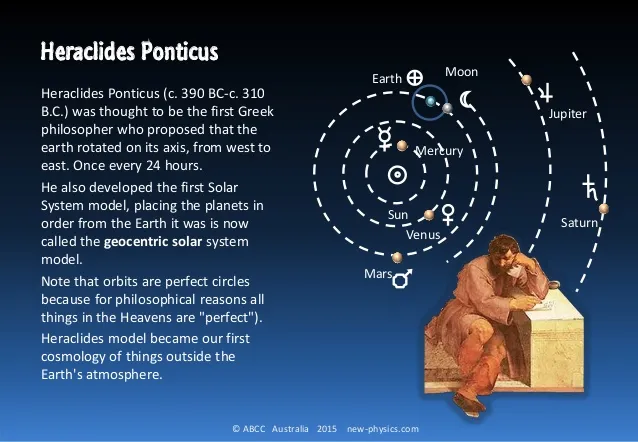
“Aristarchus (of Samos c. 270 B.C.) has brought out a book consisting of certain hypotheses .... His hypotheses are that the fixed stars and the Sun remain unmoved, that the Earth revolves about the Sun on the circumference of a circle, the Sun lying in the middle of the orbit, and that the sphere of fixed stars, situated about the same center as the Sun, is so great that the circle in which he supposes the Earth to revolve bears such a proportion to the distance of the fixed stars as the center of the sphere bears to its surface.” ~ Archimedes
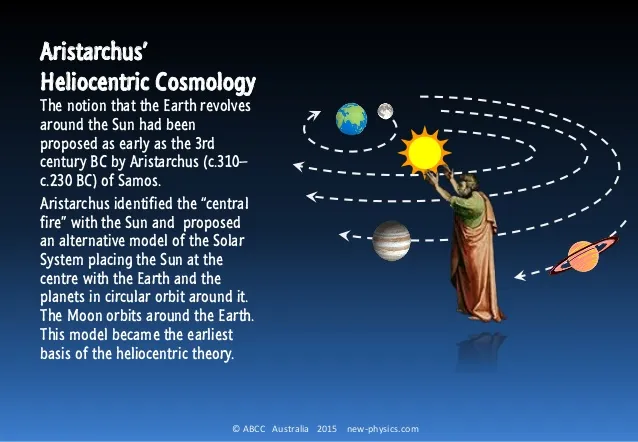
Eratosthenes (circa 205 B.C.), librarian at Alexandria, calculated the circumference of the Earth, as well as the tilt of the globe’s axis to its orbital plane. He measured the angle of the shadows of two vertical sticks at Syrene and Alexandria in Egypt, and from the angles, knowing the distance between the two cities, calculated the Earth’s circumference with a fair degree of accuracy.
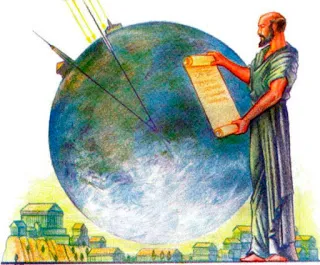
Global Eratosthenes Project – where school children around the world reproduce Eratosthenes’ experiment. These are the results from the Andean countries in 2015:
“From Monday 15 to Wednesday, June 24, 2015, about 80 teachers from Argentina, Brazil, Chile, Colombia, Peru & Venezuela, motivated by Eratosthenes, joined to work with their students to measure the size of the Earth.
“For the measurement of 21 June 2015, 1587 teachers with students registered … the Terrestrial Radius = 6363 +/‐ 126 km … the average accepted value is 6371 Km.
“We see that our result is only 8 km below the accepted value which pleases us very much and demonstrates that together we can achieve excellent results.”
source: https://eratostenes-unawe-region-andina.blogspot.com
Crates of Mallus created the first known globe circa 150 B.C. “We have now traced on a spherical surface the area in which we say the inhabited world is situated; and the man who would most closely approximate the truth by constructed figures must necessarily take for the earth a globe like that of Crates, and lay off on it the quadrilateral, and within the quadrilateral put down the map of the inhabited world.” ~ Strabo

Posidonius (c. 135-51 B.C.), using the position of the star Canopus from different latitudes, calculated the circumference of the Earth at 240,000 “stadia” = 39,000 km, ≈ actual of 40,074 km.
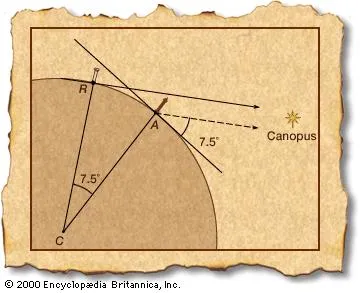
Ptolemy (2nd century A.D.), in his Geographia, used the globe as the center of the universe, and developed a system of latitude and longitude. In his astronomical work Mathematical Treatise Ptolemy proposed a system with multiple spheres for planets and stars, spheres within spheres (of crystal clear aether) to account for the apparent forward and retrograde motions of the planets against the fixed stars, (using epicycles and deferents).

Martianus Capella (5th century A.D.) expressed the idea that the planets Venus and Mercury did not go about the Earth but instead circled the Sun.
Aryabhata (499 A.D.) proposed a planetary model in which the Earth spins on its axis, with the periods of the planets taken as elliptical orbits around the Sun.
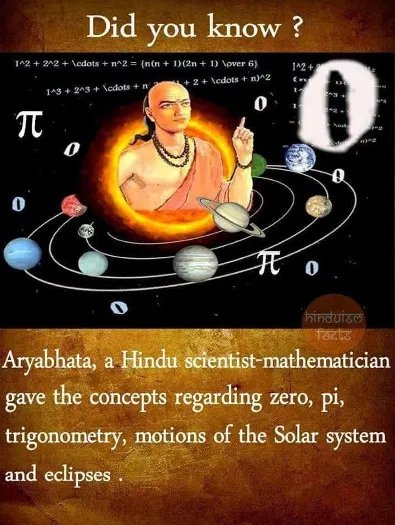
Nilakantha Somayaji (1444–1544), in his Aryabhatiyabhasya, developed a computational system for a partially heliocentric planetary model, in which the planets orbit the Sun, which in turn orbits the Earth, similar to the Tychonic system.
“That the motion we see is due to the Earth's movement and not to that of the sky.” ~ Abu Sa’id al-Sijzi (c. 1000 A.D.)
Abū Rayḥān Al-Bīrūnī (11th Century AD), the great Persian scholar, is widely acknowledged as the Father of Geodesy. He calculated Earth’s radius at approximately 6,339 kilometers, 99.5% of the correct figure, and claimed Earth rotates on its axis. He developed trigonometric formulae for geodetic and cartographic purposes. al-Biruni developed polar azimuthal equidistant projection maps which are useful for various geodetic measurement calculations.
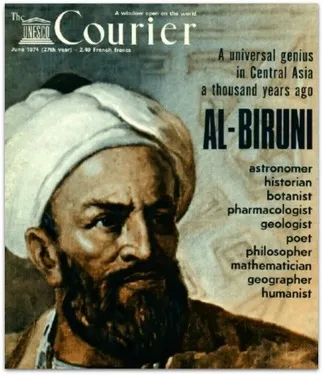
“Ancient Indians called this planet 'Bhu-gol' or the Round Earth, proving advancement over the flat-Earth theory believed by almost every other Early civilization. In his famous Book on India, Alberuni, the medieval Islamic scholar quotes an Indian astronomer Brahmagupta to write-
"A man on Meru observes one identical star above the horizon in the zenith of Lanka, the country of demons, whilst a man in Lanka at the same time observes it above his head. Besides all astronomical observations are not correct unless we assume the globular shape of heaven and earth.
“Therefore we must declare that heaven is a globe, and the observation of these characteristics of the world would not be correct unless in reality it were a globe. Now it is evident that all other theories about the world are futile."
Source: https://decodehindumythology.blogspot.com/p/historical-facts.html
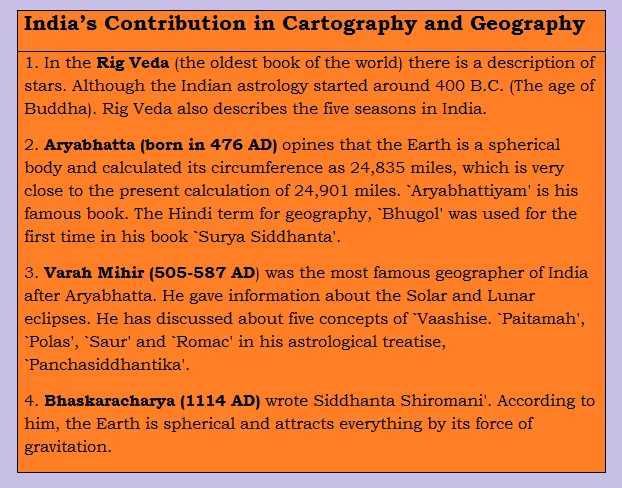
Hope you enjoyed reading this, part of a much larger project on cosmographic philosophies and realities. I'm endlessly fascinated by the mysteries of reality, and strive to understand diverse views. Different perspectives can be the greatest of teachers!
Please upvote and reSteem if you enjoyed this, thanks :) Alkemix